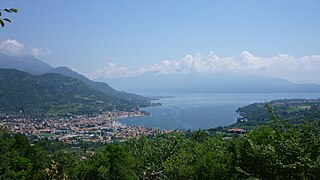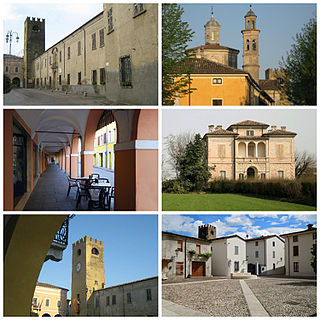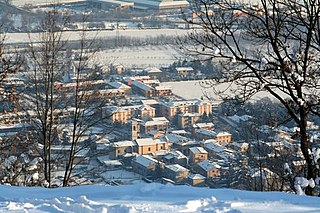
A comune is an administrative division of Italy, roughly equivalent to a township or municipality. It is the third-level administrative division of Italy, after regions and provinces. The comune can also have the title of città.

Salò is a town and comune in the Province of Brescia in the region of Lombardy on the banks of Lake Garda, on which it has the longest promenade. The city was the seat of government of the Italian Social Republic from 1943 to 1945, a state often referred to as the "Salò Republic".

Adro is a town and comune in the province of Brescia, in Lombardy, with a traditional wine-growing vocation favored by its position in the Franciacorta area.

Castel GoffredoItalian pronunciation:[kaˈstɛlɡofˈfreːdo] is a comune in the province of Mantua, in Lombardy, northern Italy, 35 kilometres (22 mi) from Mantua and a few more from Brescia. It lies in a region of springs at the foot of the slopes that drain into Lake Garda, towards the plain of the Po. Castel Goffredo borders the following municipalities: Castiglione delle Stiviere, Medole, Ceresara, Casaloldo, Asola, Acquafredda, Carpenedolo.

Collebeato is a town and comune in the province of Brescia, in Lombardy, Italy. It is located on the right bank of the river Mella, 5 kilometres (3.1 mi) north of Brescia.

Iseo is a town and comune in the province of Brescia, in Lombardy, Italy, on the south shore of Lake Iseo. It is bounded by the communes of Provaglio d'Iseo, Sulzano, Polaveno and Paratico.

Brescia Calcio, commonly referred to as Brescia, is an Italian football club based in Brescia, Lombardy, that currently plays in Serie B, the second tier of Italian football.

Rezzato is a comune in the province of Brescia, in Lombardy. It is bounded by the comunes of Brescia, Botticino, Castenedolo, Mazzano and Nuvolera.

In architecture, a loggia is a covered exterior gallery or corridor, usually on an upper level, but sometimes on the ground level of a building. The corridor is open to the elements because its outer wall is only partial, with the upper part usually supported by a series of columns or arches. An overhanging loggia may be supported by a baldresca.
Serle is a comune in the province of Brescia, in Lombardy, Italy. It is bordered by the neighboring communes of Nuvolento, Caino and Botticino.

Piazza del Duomo is the main piazza of Milan, Italy. It is named after, and dominated by, Milan Cathedral. The piazza marks the center of the city, both in a geographic sense and because of its importance from an artistic, cultural, and social point of view. Rectangular in shape, with an overall area of 17,000 m2, the piazza includes some of the most important buildings of Milan, as well some of the most prestigious commercial activities, and it is by far the foremost tourist attraction of the city.

Università Cattolica del Sacro Cuore is an Italian private research university founded in 1921. Its main campus is located in Milan, Italy, with satellite campuses in Brescia, Piacenza, Cremona and Rome.

San Salvatore is a former monastery in Brescia, Lombardy, northern Italy, now turned into a museum. The monastic complex is famous for the diversity of its architecture which includes Roman remains and significant pre-Romanesque, Romanesque and Renaissance buildings.

A broletto in medieval Italy communes was the place where the whole population met for democratic assemblies, and where the elected men lived and administered justice.

Brescia railway station is the main station of Brescia, in the region of Lombardy, northern Italy. The station, opened in 1854, lies on the Milan-Venice railway and is a terminus of three branch lines: Valcamonica Railway to Edolo, Bergamo–Brescia railway and Brescia–Piadena/Cremona railway which branches off towards southeast of the station.
Palazzo della Ragione may refer to:

The Arengario is a historic building in Monza, northern Italy. It was built in the 13th century and is named after its original function as the town's "arengario". It is located in the most central square of Monza, Piazza Roma.

The Duomo Vecchio or Old Cathedral is a Roman Catholic church in Brescia, Italy; the rustic circular Romanesque co-cathedral stands next to the Duomo Nuovo of Brescia. It is officially known as the Winter Co-Cathedral of Santa Maria Assunta, while the adjacent main cathedral is known as the Summer Cathedral.

Brescia is a city and comune (municipality) in the region of Lombardy, in northern Italy. It is situated at the foot of the Alps, a few kilometers from the lakes Garda and Iseo. With a population of more than 200,000, it is the second largest city in Lombardy and the fourth largest in northwest Italy. The urban area of Brescia extends beyond the administrative city limits and has a population of 672,822, while over 1.5 million people live in its metropolitan area. The city is the administrative capital of the Province of Brescia, one of the largest in Italy, with over 1,200,000 inhabitants.

















